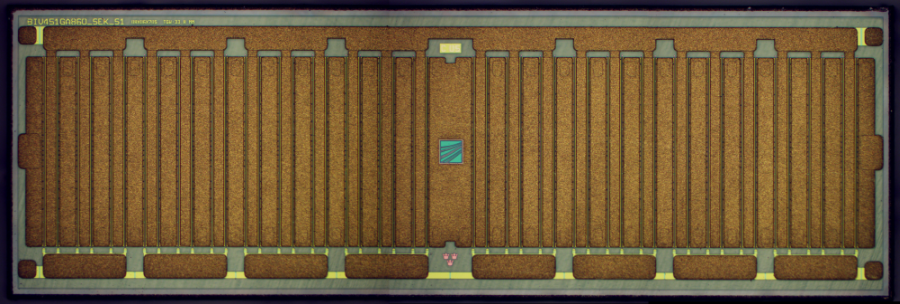Mar 25 2020
At the Fraunhofer Institute for Applied Solid State Physics IAF, scientists have been successful in considerably increasing the output power of GaN-based high-frequency transistors working in the frequency range of 1 to 2 GHz.
 A 100 V gallium nitride power transistor with an output power of 600 W at a frequency of 1.0 GHz. Image Credit: © Fraunhofer IAF.
A 100 V gallium nitride power transistor with an output power of 600 W at a frequency of 1.0 GHz. Image Credit: © Fraunhofer IAF.
The researchers could double the operating voltage of the devices from 50 V to 100 V, thus realizing a power-added efficiency of 77.3%. This technology enables the designing of highly efficient amplifiers with a much higher power, necessary for applications in the fields of communications, industrial heating, plasma generation, and radar technologies.
One of the main essential requirements for the use of transistors in high-power applications in the GigaHertz range is their power density. This factor governs the size of amplifier modules and thus mainly the system complexity—both of which are crucial for the needed use of resources and the costs of manufacturing.
Various methods are available to enhance the power density of transistors. The scientists at Fraunhofer IAF have preferred the method of increasing the operating voltage: they scaled the transistor design laterally and vertically, thus being successful, for the first time in Europe, in achieving high-frequency transistors appropriate for applications at a 100 V operating voltage.
Such devices based on the semiconductor gallium nitride (GaN) exhibit considerably increased power density at frequencies in the range of GigaHertz.
Laboratory Measurements Show Record Efficiency
Researchers have already demonstrated the performance of the newly developed devices for the frequency range of 1 to 2 GHz in the laboratory: Measurements revealed a power-added efficiency (PAE) of 77.3% and a power density of over 17 W/mm at a frequency of 1.0 GHz.
This is the maximum power-added efficiency ever realized for operation at 100 V in this frequency range. The tests have also demonstrated that this technology offers a power density of more than 20 W/mm at an operating voltage of 125 V.
For the first time, in December 2019, the scientists reported their findings at the International Electron Devices Meeting (IEDM) in San Francisco.
Twice the Voltage for Much Higher Power
Increasing the operating voltage from 50 to 100 volts enables higher power densities. This means that a system can deliver more power on the same area than what is possible with commercially available 50 V or 65 V technologies.
Sebastian Krause, Researcher, Fraunhofer Institute for Applied Solid State Physics
Krause is one of the main developers of the technology. This method not only allows systems of similar size with higher output power, but also makes it possible to develop highly compact and lighter systems that offer the same power. This is because less chip area is needed to obtain the desired power level.
By doubling the operating voltage to 100 V, the transistor exhibits a four times higher output impedance for a given power.
Sebastian Krause, Researcher, Fraunhofer Institute for Applied Solid State Physics
This method enables the implementation of smaller systems and thus matching networks with reduced loss. As a result, it helps achieve higher energy efficiency of the entire system.
Usage in Industrial High-Power Systems
According to Krause, “The long-term goal of our development is operation through 10 GHz.” Thus, the Freiburg-based Fraunhofer Institute would be the primary source for such 100 V GaN-based devices.
This study is of special interest for high-performance applications like mobile-phone amplifiers, industrial microwave heaters, particle accelerators, amplifiers for plasma generators, and pulse-and continuous-wave radar. Such systems would need high output power levels while retaining a desirably small footprint—this is precisely what the 100-V technology can offer.
Particle accelerators play a vital role in several fields like medical technology, industry, and research. High-frequency-range plasma generators are employed, for instance, for coating processes during the manufacture of data-storage media, semiconductor-based chips, or solar cells.
Power Semiconductors Replace Vacuum Components
Another wider industrial field of application is power generators used for microwave heating.
In this field, industry usually works at higher frequencies, but vacuum components, e.g. magnetrons or klystrons, are predominantly used to date. Here, we are working on providing a semiconductor-based alternative. Semiconductors are much more compact and more lightweight, which enables arrangements such as phased arrays.
Sebastian Krause, Researcher, Fraunhofer Institute for Applied Solid State Physics
For a long period, tube-based components such as traveling wave tubes have been predominantly used in electronic systems with high output power. However, the focus is now on power semiconductors.
The researchers at Fraunhofer IAF consider that the GaN-based 100 V technology could be an efficient option for enhancing the power of microwave generators.